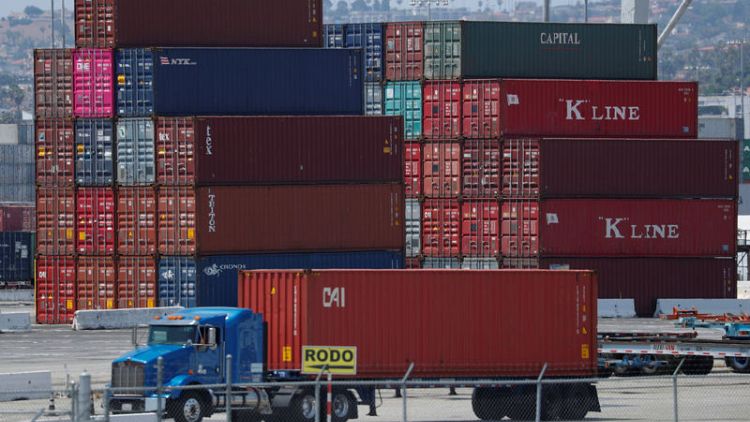By Lucia Mutikani
WASHINGTON (Reuters) - A measure of U.S. factory activity retreated from a more than 14-year high in September as growth in new orders slowed, but supply bottlenecks appeared to be easing, suggesting a steady pace of expansion in manufacturing.
Other data on Monday showed a small increase in construction spending in August amid weakness in investment in private residential and nonresidential projects. The report did little to change views of strong economic growth in the third quarter.
The Institute for Supply Management (ISM) said its index of national factory activity dropped 1.5 points to a reading of 59.8 last month from 61.3 in August, which was the highest since May 2004. A reading above 50 indicates growth in manufacturing, which accounts for about 12 percent of the U.S. economy.
"It may not be the best of times for manufacturers, but it is pretty close to that," said Joel Naroff, chief economist at Naroff Economic Advisors in Holland, Pennsylvania.
The ISM continued to describe demand as remaining "robust." The ISM also noted that "the nation's employment resource and supply chains continued to struggle, but to a lesser degree." It said factories remained "overwhelmingly concerned about tariff-related activity, including how reciprocal tariffs will impact company revenue and current manufacturing locations."
President Donald Trump's "America First" trade policy have left the United States embroiled in a bitter trade war with China and tit-for-tat import tariffs with other trading partners, including the European Union, Canada and Mexico.
Washington last week slapped tariffs on $200 billion worth of Chinese goods, with Beijing retaliating with duties on $60 billion worth of U.S. products. The United States and China had already imposed tariffs on $50 billion worth of each other's goods.
The United States salvaged a trilateral free trade accord with Canada and Mexico on Sunday, which underpins $1.2 trillion in trade between the three countries.
While data have suggested little impact on the economy so far from the tariffs, analysts warn that the import duties could disrupt supply chains, undercut business investment and slow the economy's momentum.
According to the ISM survey, some managers in the computer and electronic products industry said "the market is in a state of chaos with the latest round of tariffs." Their counterparts in the chemical products sector complained that "tariffs (are) starting to take a bite out of profitability."
FACTORY EMPLOYMENT RISES
The ISM's new orders sub-index fell to a reading of 61.8 last month from 65.1 in August. The survey's factory employment measure rose to 58.8, the highest reading since February, from 58.5 in August.
This suggests manufacturing payrolls probably rebounded in September after falling in August for the first time in 13 months. The government will publish September's employment report on Friday.
The ISM's supplier deliveries index fell to a reading of 61.1 last month, pointing to some easing in bottlenecks in the supply chain, from 64.5 in August. It hit a 14-year high of 68.2 in June. The ISM's prices paid measure fell to a 10-month low in September.
U.S. stocks were trading higher as investors breathed a sigh of relief following the trade pact between the United States, Canada and Mexico. The dollar firmed marginally against a basket of currencies and U.S. Treasury yield rose.
A second report from the Commerce Department showed construction spending edged up 0.1 percent in August after rising 0.2 percent in July.
Spending on public construction projects jumped 2.0 percent in August to the highest level since July 2009. That followed a 1.7 percent increase in July. Spending on federal government construction projects soared 5.9 percent to a 10-month high after increasing 2.3 percent in July.
State and local government construction outlays accelerated 1.7 percent in August to the highest level since March 2009. That followed a 1.6 percent rise in July.
But spending on private construction projects fell 0.5 percent in August after decreasing 0.2 percent in July. Private construction outlays have now declined for three straight months. Investment in private residential projects fell 0.7 percent in August after gaining 0.2 percent in July.
Homebuilding has been constrained by rising material costs as well as persistent land and labour shortages. Residential investment contracted in the first half of the year and is expected to have declined further in the third quarter.
Spending on private nonresidential structures, which includes manufacturing and power plants, slipped 0.2 percent in August after declining 0.8 percent in July.
"We expect that residential investment will again weigh on real GDP growth in the third quarter," said Veronica Clark, an economist at Citigroup in New York. "However, the continued decline in nonresidential construction spending implies downside to nonresidential structures investment in third-quarter GDP."
Growth estimates for the third quarter are above a 3.0 percent annualised rate. The economy grew at a 4.2 percent pace in the second quarter.
(Reporting By Lucia Mutikani; Editing by Andrea Ricci)



